Critical Appraisal: Healthcare Research Articles Analysis
VerifiedAdded on 2022/12/15
|13
|3911
|102
Homework Assignment
AI Summary
This assignment presents a critical appraisal of two research articles in the healthcare field. The first article, a quantitative study published in BMJ, examines the comparative effectiveness of Tai Chi versus aerobic exercise for fibromyalgia. The appraisal focuses on the study's methodology, including randomization, patient accounting, blinding, group similarity, treatment effect size, precision, applicability, and consideration of important outcomes. The second article, a qualitative study also published in BMJ, investigates the decision-making processes of family carers for individuals with dementia. The appraisal evaluates the study's aims, methodology, research design, recruitment strategy, data analysis, and ethical considerations. The assignment assesses the validity, results, and relevance of both studies, providing a comprehensive analysis of their strengths, limitations, and potential impact on clinical practice. The assignment follows a structured approach, answering specific questions related to each study's design, execution, and conclusions.
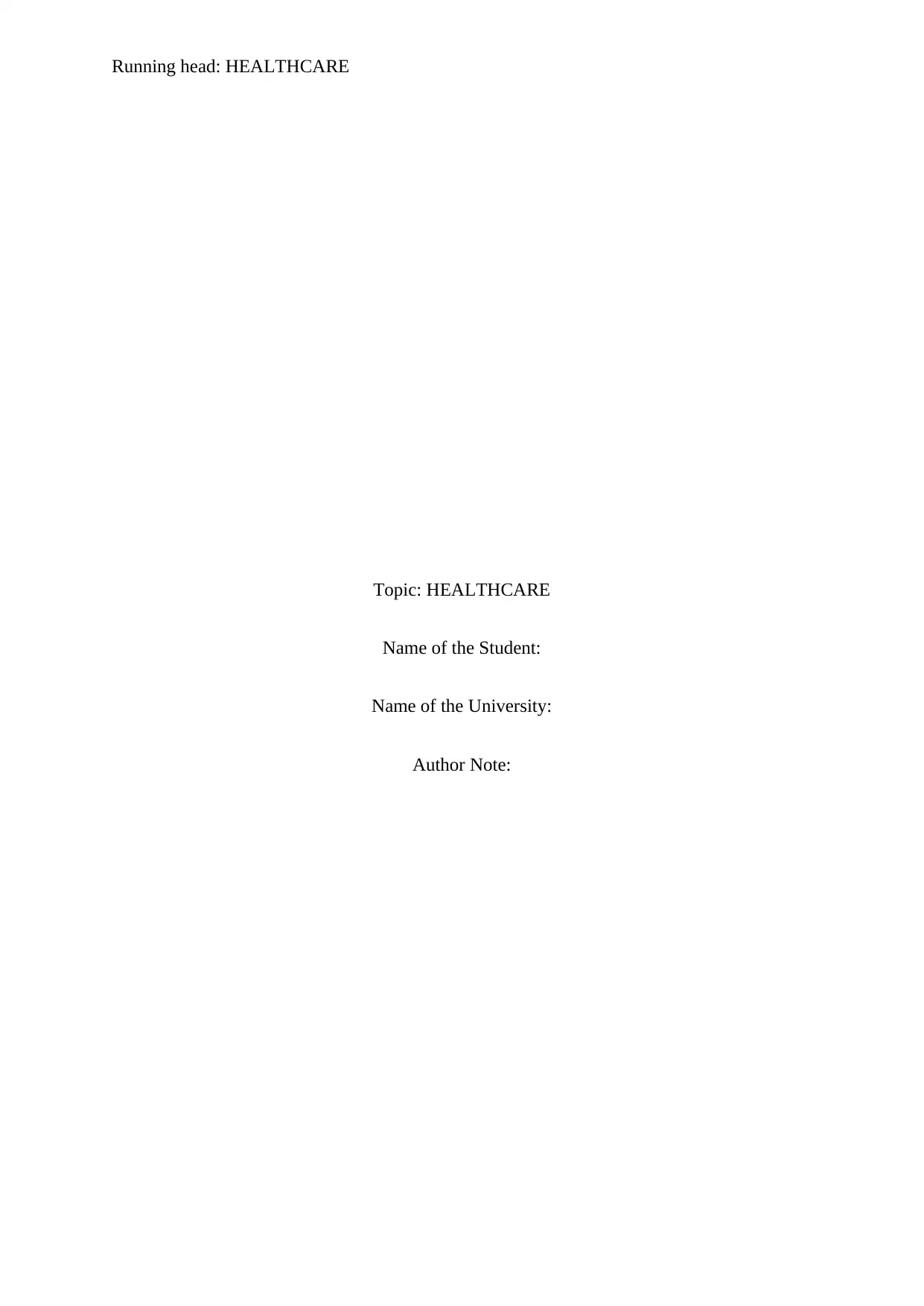
Running head: HEALTHCARE
Topic: HEALTHCARE
Name of the Student:
Name of the University:
Author Note:
Topic: HEALTHCARE
Name of the Student:
Name of the University:
Author Note:
Paraphrase This Document
Need a fresh take? Get an instant paraphrase of this document with our AI Paraphraser

1HEALTHCARE
Critical appraisal
Quantitative article: Wang, C., Schmid, C. H., Fielding, R. A., Harvey, W. F., Reid, K. F.,
Price, L. L., ... & McAlindon, T. (2018). Effect of tai chi versus aerobic exercise for
fibromyalgia: comparative effectiveness randomized controlled trial. bmj, 360, k851.
1. Did the trial address a clearly focused issue?
This paper is about Fibromyalgia, which is defined as complex disorders characterised by the
chronic fatigue, musculoskeletal pain, and sleep disturbances. While various drug
interventions has shown benefits against fibromyalgia, but recently aerobic exercises has
been recommended as a gold standard of care for the fibromyalgia. This study has compared
effectiveness of aerobic exercises and Tai -Chi for the fibromyalgia. It is also inclusive of
evaluating the effectiveness inclusive of tai-chi depended upon the duration and the dosage.
2. Was the assignment of patients to treatments randomised?
A prospective, randomised and single blinded trial has been conducted in tertiary care
hospital located in the urban areas of United States between March 2012, as well as
September 2016. 226 adult participants were being chosen for the study and there were
randomly assigned to either a aerobic exercise which has been supervised or one in the Yang
style supervised by Tai-chi exercise. Randomisation ensures that experimental control has
been used extensively. It is used for preventing selection based biasness and ensures against
any accidental bias (Senn, 2013). It does so by producing comparable groups and helps to
eliminate the sources of bias the treatment assignments.
3. Were all of the patients who entered the trial properly accounted for at its conclusion?
The trial was not stopped early and adherence of participants to the study was extensively
encouraged in person by the telephone. 12 or 24 weeks inclusive of supervised Tai-Chi
Critical appraisal
Quantitative article: Wang, C., Schmid, C. H., Fielding, R. A., Harvey, W. F., Reid, K. F.,
Price, L. L., ... & McAlindon, T. (2018). Effect of tai chi versus aerobic exercise for
fibromyalgia: comparative effectiveness randomized controlled trial. bmj, 360, k851.
1. Did the trial address a clearly focused issue?
This paper is about Fibromyalgia, which is defined as complex disorders characterised by the
chronic fatigue, musculoskeletal pain, and sleep disturbances. While various drug
interventions has shown benefits against fibromyalgia, but recently aerobic exercises has
been recommended as a gold standard of care for the fibromyalgia. This study has compared
effectiveness of aerobic exercises and Tai -Chi for the fibromyalgia. It is also inclusive of
evaluating the effectiveness inclusive of tai-chi depended upon the duration and the dosage.
2. Was the assignment of patients to treatments randomised?
A prospective, randomised and single blinded trial has been conducted in tertiary care
hospital located in the urban areas of United States between March 2012, as well as
September 2016. 226 adult participants were being chosen for the study and there were
randomly assigned to either a aerobic exercise which has been supervised or one in the Yang
style supervised by Tai-chi exercise. Randomisation ensures that experimental control has
been used extensively. It is used for preventing selection based biasness and ensures against
any accidental bias (Senn, 2013). It does so by producing comparable groups and helps to
eliminate the sources of bias the treatment assignments.
3. Were all of the patients who entered the trial properly accounted for at its conclusion?
The trial was not stopped early and adherence of participants to the study was extensively
encouraged in person by the telephone. 12 or 24 weeks inclusive of supervised Tai-Chi
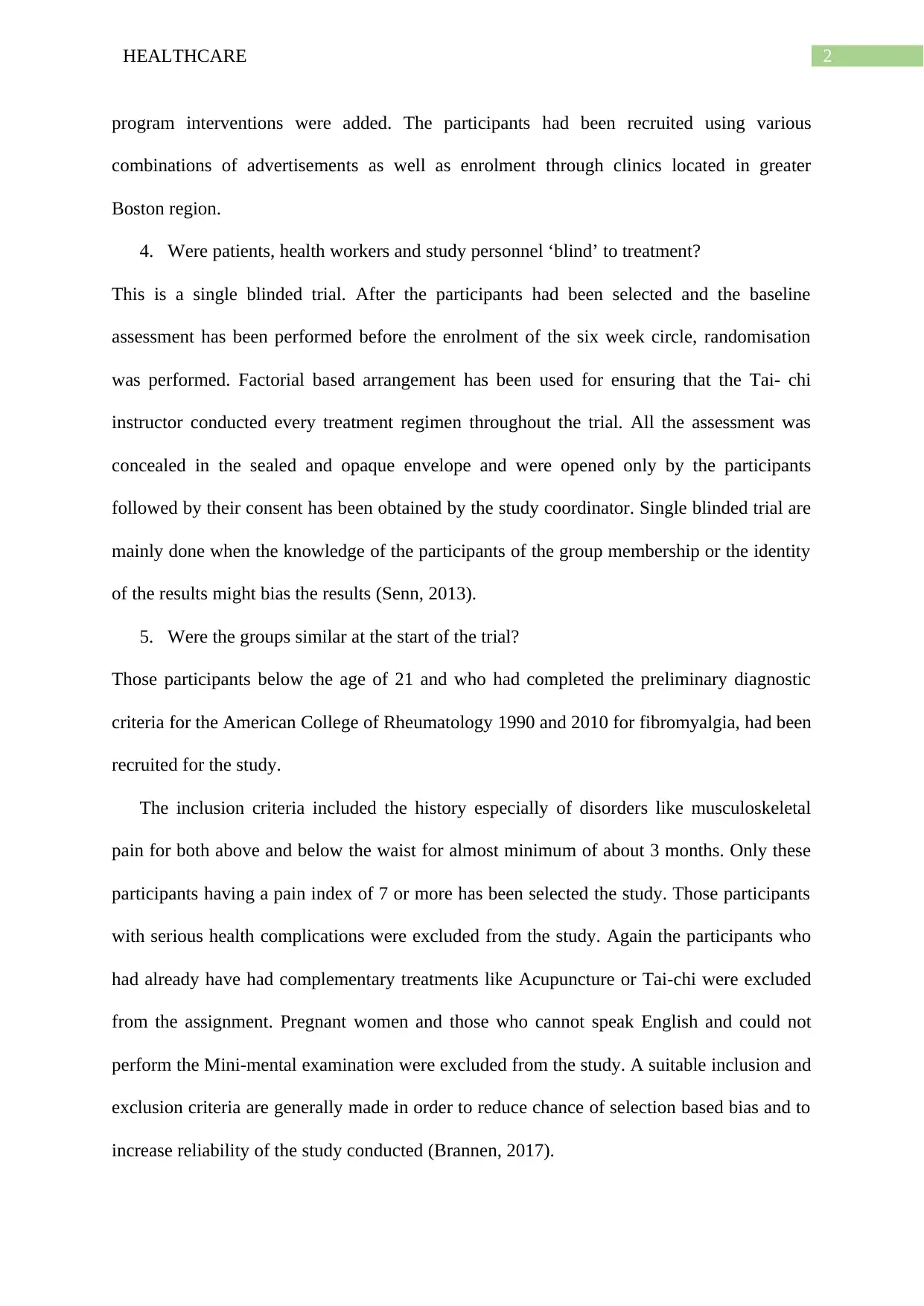
2HEALTHCARE
program interventions were added. The participants had been recruited using various
combinations of advertisements as well as enrolment through clinics located in greater
Boston region.
4. Were patients, health workers and study personnel ‘blind’ to treatment?
This is a single blinded trial. After the participants had been selected and the baseline
assessment has been performed before the enrolment of the six week circle, randomisation
was performed. Factorial based arrangement has been used for ensuring that the Tai- chi
instructor conducted every treatment regimen throughout the trial. All the assessment was
concealed in the sealed and opaque envelope and were opened only by the participants
followed by their consent has been obtained by the study coordinator. Single blinded trial are
mainly done when the knowledge of the participants of the group membership or the identity
of the results might bias the results (Senn, 2013).
5. Were the groups similar at the start of the trial?
Those participants below the age of 21 and who had completed the preliminary diagnostic
criteria for the American College of Rheumatology 1990 and 2010 for fibromyalgia, had been
recruited for the study.
The inclusion criteria included the history especially of disorders like musculoskeletal
pain for both above and below the waist for almost minimum of about 3 months. Only these
participants having a pain index of 7 or more has been selected the study. Those participants
with serious health complications were excluded from the study. Again the participants who
had already have had complementary treatments like Acupuncture or Tai-chi were excluded
from the assignment. Pregnant women and those who cannot speak English and could not
perform the Mini-mental examination were excluded from the study. A suitable inclusion and
exclusion criteria are generally made in order to reduce chance of selection based bias and to
increase reliability of the study conducted (Brannen, 2017).
program interventions were added. The participants had been recruited using various
combinations of advertisements as well as enrolment through clinics located in greater
Boston region.
4. Were patients, health workers and study personnel ‘blind’ to treatment?
This is a single blinded trial. After the participants had been selected and the baseline
assessment has been performed before the enrolment of the six week circle, randomisation
was performed. Factorial based arrangement has been used for ensuring that the Tai- chi
instructor conducted every treatment regimen throughout the trial. All the assessment was
concealed in the sealed and opaque envelope and were opened only by the participants
followed by their consent has been obtained by the study coordinator. Single blinded trial are
mainly done when the knowledge of the participants of the group membership or the identity
of the results might bias the results (Senn, 2013).
5. Were the groups similar at the start of the trial?
Those participants below the age of 21 and who had completed the preliminary diagnostic
criteria for the American College of Rheumatology 1990 and 2010 for fibromyalgia, had been
recruited for the study.
The inclusion criteria included the history especially of disorders like musculoskeletal
pain for both above and below the waist for almost minimum of about 3 months. Only these
participants having a pain index of 7 or more has been selected the study. Those participants
with serious health complications were excluded from the study. Again the participants who
had already have had complementary treatments like Acupuncture or Tai-chi were excluded
from the assignment. Pregnant women and those who cannot speak English and could not
perform the Mini-mental examination were excluded from the study. A suitable inclusion and
exclusion criteria are generally made in order to reduce chance of selection based bias and to
increase reliability of the study conducted (Brannen, 2017).
⊘ This is a preview!⊘
Do you want full access?
Subscribe today to unlock all pages.

Trusted by 1+ million students worldwide
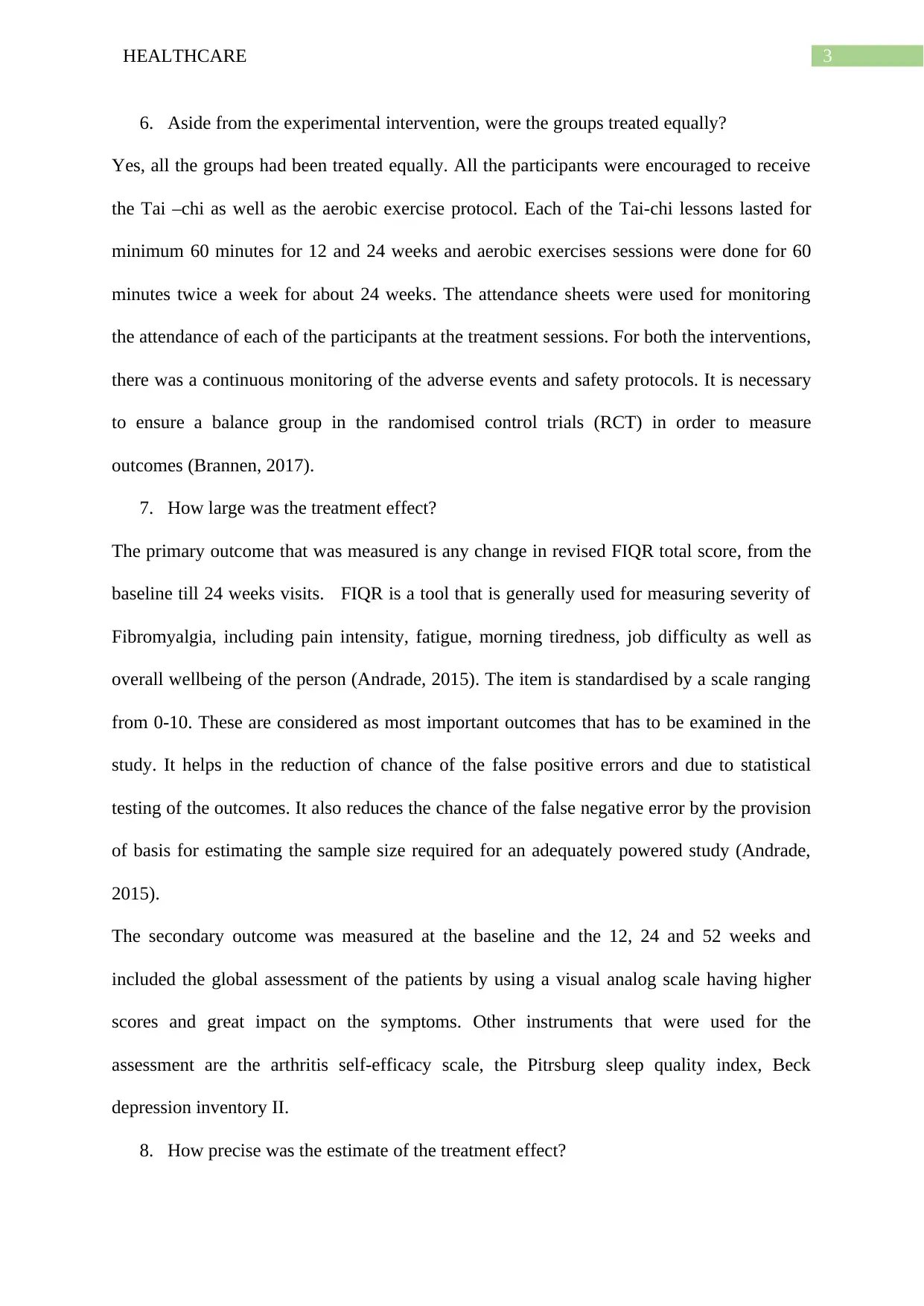
3HEALTHCARE
6. Aside from the experimental intervention, were the groups treated equally?
Yes, all the groups had been treated equally. All the participants were encouraged to receive
the Tai –chi as well as the aerobic exercise protocol. Each of the Tai-chi lessons lasted for
minimum 60 minutes for 12 and 24 weeks and aerobic exercises sessions were done for 60
minutes twice a week for about 24 weeks. The attendance sheets were used for monitoring
the attendance of each of the participants at the treatment sessions. For both the interventions,
there was a continuous monitoring of the adverse events and safety protocols. It is necessary
to ensure a balance group in the randomised control trials (RCT) in order to measure
outcomes (Brannen, 2017).
7. How large was the treatment effect?
The primary outcome that was measured is any change in revised FIQR total score, from the
baseline till 24 weeks visits. FIQR is a tool that is generally used for measuring severity of
Fibromyalgia, including pain intensity, fatigue, morning tiredness, job difficulty as well as
overall wellbeing of the person (Andrade, 2015). The item is standardised by a scale ranging
from 0-10. These are considered as most important outcomes that has to be examined in the
study. It helps in the reduction of chance of the false positive errors and due to statistical
testing of the outcomes. It also reduces the chance of the false negative error by the provision
of basis for estimating the sample size required for an adequately powered study (Andrade,
2015).
The secondary outcome was measured at the baseline and the 12, 24 and 52 weeks and
included the global assessment of the patients by using a visual analog scale having higher
scores and great impact on the symptoms. Other instruments that were used for the
assessment are the arthritis self-efficacy scale, the Pitrsburg sleep quality index, Beck
depression inventory II.
8. How precise was the estimate of the treatment effect?
6. Aside from the experimental intervention, were the groups treated equally?
Yes, all the groups had been treated equally. All the participants were encouraged to receive
the Tai –chi as well as the aerobic exercise protocol. Each of the Tai-chi lessons lasted for
minimum 60 minutes for 12 and 24 weeks and aerobic exercises sessions were done for 60
minutes twice a week for about 24 weeks. The attendance sheets were used for monitoring
the attendance of each of the participants at the treatment sessions. For both the interventions,
there was a continuous monitoring of the adverse events and safety protocols. It is necessary
to ensure a balance group in the randomised control trials (RCT) in order to measure
outcomes (Brannen, 2017).
7. How large was the treatment effect?
The primary outcome that was measured is any change in revised FIQR total score, from the
baseline till 24 weeks visits. FIQR is a tool that is generally used for measuring severity of
Fibromyalgia, including pain intensity, fatigue, morning tiredness, job difficulty as well as
overall wellbeing of the person (Andrade, 2015). The item is standardised by a scale ranging
from 0-10. These are considered as most important outcomes that has to be examined in the
study. It helps in the reduction of chance of the false positive errors and due to statistical
testing of the outcomes. It also reduces the chance of the false negative error by the provision
of basis for estimating the sample size required for an adequately powered study (Andrade,
2015).
The secondary outcome was measured at the baseline and the 12, 24 and 52 weeks and
included the global assessment of the patients by using a visual analog scale having higher
scores and great impact on the symptoms. Other instruments that were used for the
assessment are the arthritis self-efficacy scale, the Pitrsburg sleep quality index, Beck
depression inventory II.
8. How precise was the estimate of the treatment effect?
Paraphrase This Document
Need a fresh take? Get an instant paraphrase of this document with our AI Paraphraser
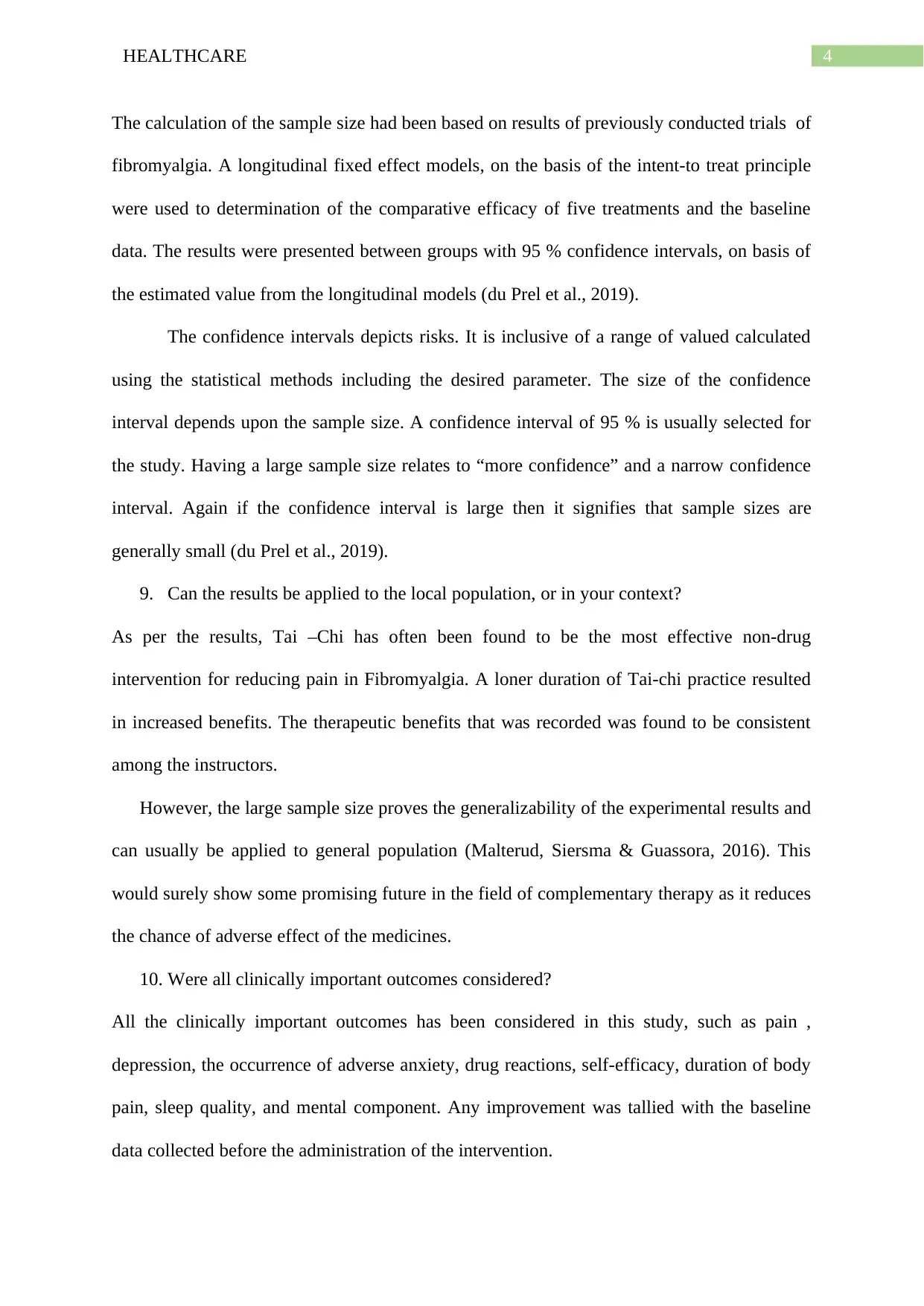
4HEALTHCARE
The calculation of the sample size had been based on results of previously conducted trials of
fibromyalgia. A longitudinal fixed effect models, on the basis of the intent-to treat principle
were used to determination of the comparative efficacy of five treatments and the baseline
data. The results were presented between groups with 95 % confidence intervals, on basis of
the estimated value from the longitudinal models (du Prel et al., 2019).
The confidence intervals depicts risks. It is inclusive of a range of valued calculated
using the statistical methods including the desired parameter. The size of the confidence
interval depends upon the sample size. A confidence interval of 95 % is usually selected for
the study. Having a large sample size relates to “more confidence” and a narrow confidence
interval. Again if the confidence interval is large then it signifies that sample sizes are
generally small (du Prel et al., 2019).
9. Can the results be applied to the local population, or in your context?
As per the results, Tai –Chi has often been found to be the most effective non-drug
intervention for reducing pain in Fibromyalgia. A loner duration of Tai-chi practice resulted
in increased benefits. The therapeutic benefits that was recorded was found to be consistent
among the instructors.
However, the large sample size proves the generalizability of the experimental results and
can usually be applied to general population (Malterud, Siersma & Guassora, 2016). This
would surely show some promising future in the field of complementary therapy as it reduces
the chance of adverse effect of the medicines.
10. Were all clinically important outcomes considered?
All the clinically important outcomes has been considered in this study, such as pain ,
depression, the occurrence of adverse anxiety, drug reactions, self-efficacy, duration of body
pain, sleep quality, and mental component. Any improvement was tallied with the baseline
data collected before the administration of the intervention.
The calculation of the sample size had been based on results of previously conducted trials of
fibromyalgia. A longitudinal fixed effect models, on the basis of the intent-to treat principle
were used to determination of the comparative efficacy of five treatments and the baseline
data. The results were presented between groups with 95 % confidence intervals, on basis of
the estimated value from the longitudinal models (du Prel et al., 2019).
The confidence intervals depicts risks. It is inclusive of a range of valued calculated
using the statistical methods including the desired parameter. The size of the confidence
interval depends upon the sample size. A confidence interval of 95 % is usually selected for
the study. Having a large sample size relates to “more confidence” and a narrow confidence
interval. Again if the confidence interval is large then it signifies that sample sizes are
generally small (du Prel et al., 2019).
9. Can the results be applied to the local population, or in your context?
As per the results, Tai –Chi has often been found to be the most effective non-drug
intervention for reducing pain in Fibromyalgia. A loner duration of Tai-chi practice resulted
in increased benefits. The therapeutic benefits that was recorded was found to be consistent
among the instructors.
However, the large sample size proves the generalizability of the experimental results and
can usually be applied to general population (Malterud, Siersma & Guassora, 2016). This
would surely show some promising future in the field of complementary therapy as it reduces
the chance of adverse effect of the medicines.
10. Were all clinically important outcomes considered?
All the clinically important outcomes has been considered in this study, such as pain ,
depression, the occurrence of adverse anxiety, drug reactions, self-efficacy, duration of body
pain, sleep quality, and mental component. Any improvement was tallied with the baseline
data collected before the administration of the intervention.
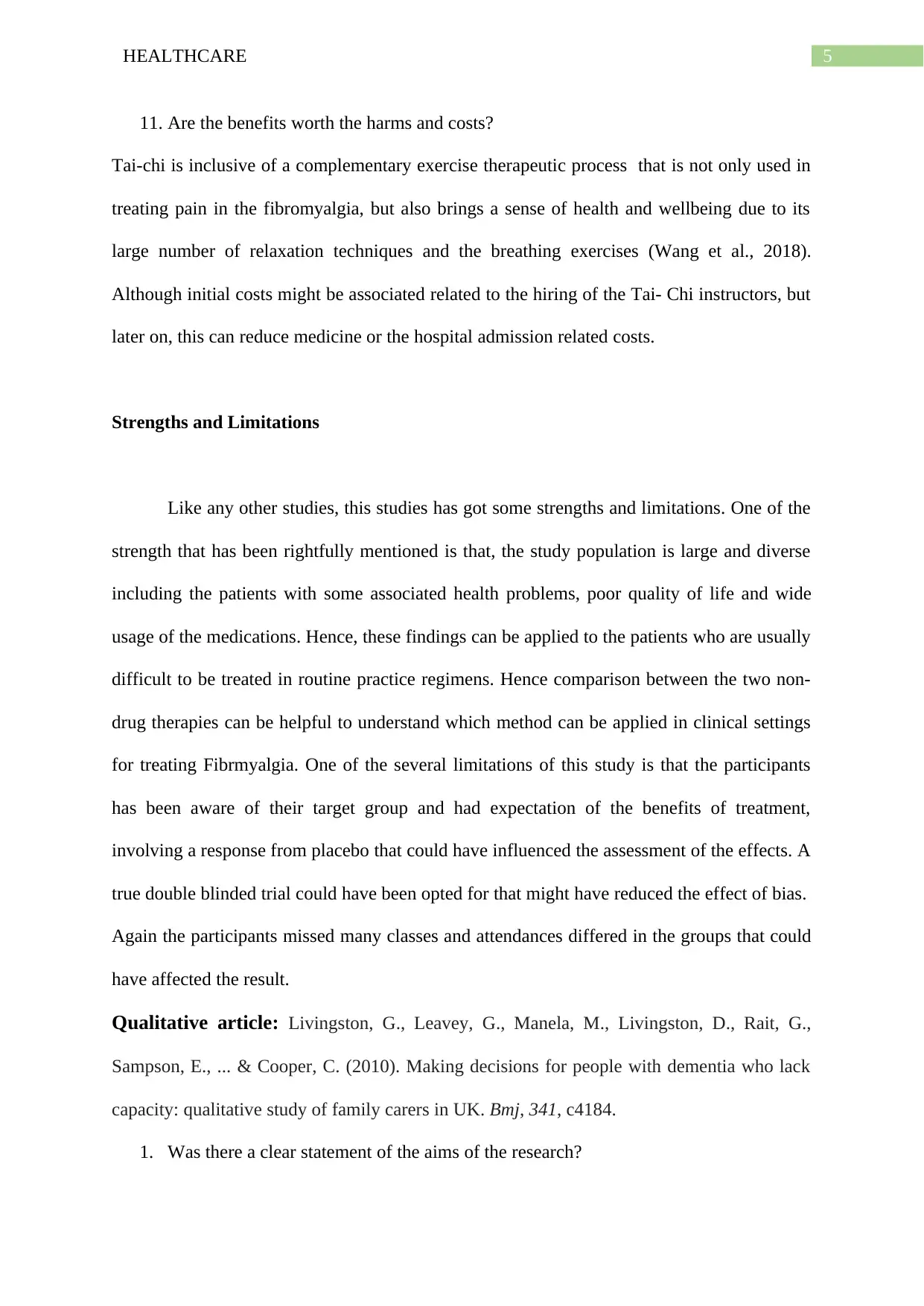
5HEALTHCARE
11. Are the benefits worth the harms and costs?
Tai-chi is inclusive of a complementary exercise therapeutic process that is not only used in
treating pain in the fibromyalgia, but also brings a sense of health and wellbeing due to its
large number of relaxation techniques and the breathing exercises (Wang et al., 2018).
Although initial costs might be associated related to the hiring of the Tai- Chi instructors, but
later on, this can reduce medicine or the hospital admission related costs.
Strengths and Limitations
Like any other studies, this studies has got some strengths and limitations. One of the
strength that has been rightfully mentioned is that, the study population is large and diverse
including the patients with some associated health problems, poor quality of life and wide
usage of the medications. Hence, these findings can be applied to the patients who are usually
difficult to be treated in routine practice regimens. Hence comparison between the two non-
drug therapies can be helpful to understand which method can be applied in clinical settings
for treating Fibrmyalgia. One of the several limitations of this study is that the participants
has been aware of their target group and had expectation of the benefits of treatment,
involving a response from placebo that could have influenced the assessment of the effects. A
true double blinded trial could have been opted for that might have reduced the effect of bias.
Again the participants missed many classes and attendances differed in the groups that could
have affected the result.
Qualitative article: Livingston, G., Leavey, G., Manela, M., Livingston, D., Rait, G.,
Sampson, E., ... & Cooper, C. (2010). Making decisions for people with dementia who lack
capacity: qualitative study of family carers in UK. Bmj, 341, c4184.
1. Was there a clear statement of the aims of the research?
11. Are the benefits worth the harms and costs?
Tai-chi is inclusive of a complementary exercise therapeutic process that is not only used in
treating pain in the fibromyalgia, but also brings a sense of health and wellbeing due to its
large number of relaxation techniques and the breathing exercises (Wang et al., 2018).
Although initial costs might be associated related to the hiring of the Tai- Chi instructors, but
later on, this can reduce medicine or the hospital admission related costs.
Strengths and Limitations
Like any other studies, this studies has got some strengths and limitations. One of the
strength that has been rightfully mentioned is that, the study population is large and diverse
including the patients with some associated health problems, poor quality of life and wide
usage of the medications. Hence, these findings can be applied to the patients who are usually
difficult to be treated in routine practice regimens. Hence comparison between the two non-
drug therapies can be helpful to understand which method can be applied in clinical settings
for treating Fibrmyalgia. One of the several limitations of this study is that the participants
has been aware of their target group and had expectation of the benefits of treatment,
involving a response from placebo that could have influenced the assessment of the effects. A
true double blinded trial could have been opted for that might have reduced the effect of bias.
Again the participants missed many classes and attendances differed in the groups that could
have affected the result.
Qualitative article: Livingston, G., Leavey, G., Manela, M., Livingston, D., Rait, G.,
Sampson, E., ... & Cooper, C. (2010). Making decisions for people with dementia who lack
capacity: qualitative study of family carers in UK. Bmj, 341, c4184.
1. Was there a clear statement of the aims of the research?
⊘ This is a preview!⊘
Do you want full access?
Subscribe today to unlock all pages.

Trusted by 1+ million students worldwide
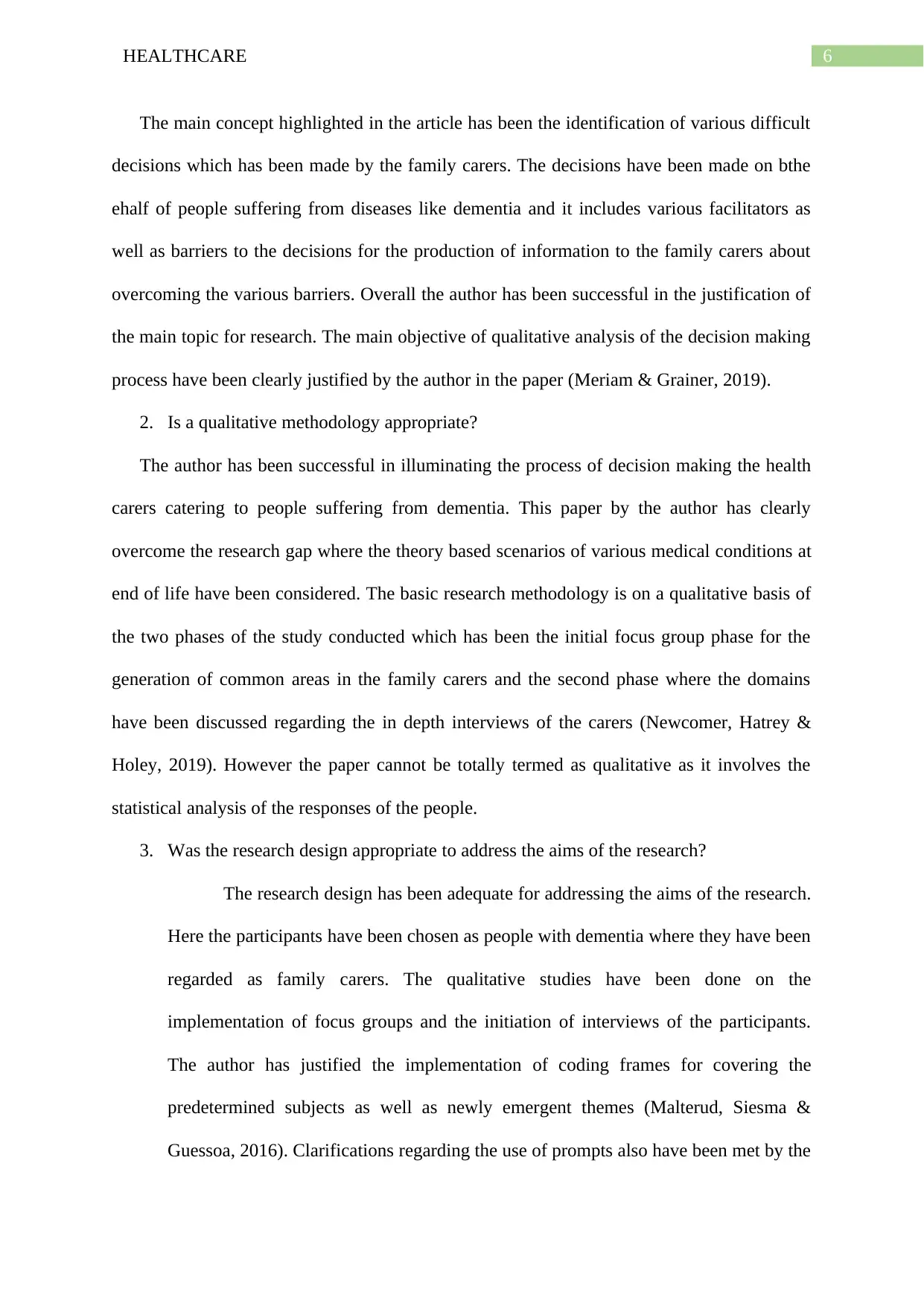
6HEALTHCARE
The main concept highlighted in the article has been the identification of various difficult
decisions which has been made by the family carers. The decisions have been made on bthe
ehalf of people suffering from diseases like dementia and it includes various facilitators as
well as barriers to the decisions for the production of information to the family carers about
overcoming the various barriers. Overall the author has been successful in the justification of
the main topic for research. The main objective of qualitative analysis of the decision making
process have been clearly justified by the author in the paper (Meriam & Grainer, 2019).
2. Is a qualitative methodology appropriate?
The author has been successful in illuminating the process of decision making the health
carers catering to people suffering from dementia. This paper by the author has clearly
overcome the research gap where the theory based scenarios of various medical conditions at
end of life have been considered. The basic research methodology is on a qualitative basis of
the two phases of the study conducted which has been the initial focus group phase for the
generation of common areas in the family carers and the second phase where the domains
have been discussed regarding the in depth interviews of the carers (Newcomer, Hatrey &
Holey, 2019). However the paper cannot be totally termed as qualitative as it involves the
statistical analysis of the responses of the people.
3. Was the research design appropriate to address the aims of the research?
The research design has been adequate for addressing the aims of the research.
Here the participants have been chosen as people with dementia where they have been
regarded as family carers. The qualitative studies have been done on the
implementation of focus groups and the initiation of interviews of the participants.
The author has justified the implementation of coding frames for covering the
predetermined subjects as well as newly emergent themes (Malterud, Siesma &
Guessoa, 2016). Clarifications regarding the use of prompts also have been met by the
The main concept highlighted in the article has been the identification of various difficult
decisions which has been made by the family carers. The decisions have been made on bthe
ehalf of people suffering from diseases like dementia and it includes various facilitators as
well as barriers to the decisions for the production of information to the family carers about
overcoming the various barriers. Overall the author has been successful in the justification of
the main topic for research. The main objective of qualitative analysis of the decision making
process have been clearly justified by the author in the paper (Meriam & Grainer, 2019).
2. Is a qualitative methodology appropriate?
The author has been successful in illuminating the process of decision making the health
carers catering to people suffering from dementia. This paper by the author has clearly
overcome the research gap where the theory based scenarios of various medical conditions at
end of life have been considered. The basic research methodology is on a qualitative basis of
the two phases of the study conducted which has been the initial focus group phase for the
generation of common areas in the family carers and the second phase where the domains
have been discussed regarding the in depth interviews of the carers (Newcomer, Hatrey &
Holey, 2019). However the paper cannot be totally termed as qualitative as it involves the
statistical analysis of the responses of the people.
3. Was the research design appropriate to address the aims of the research?
The research design has been adequate for addressing the aims of the research.
Here the participants have been chosen as people with dementia where they have been
regarded as family carers. The qualitative studies have been done on the
implementation of focus groups and the initiation of interviews of the participants.
The author has justified the implementation of coding frames for covering the
predetermined subjects as well as newly emergent themes (Malterud, Siesma &
Guessoa, 2016). Clarifications regarding the use of prompts also have been met by the
Paraphrase This Document
Need a fresh take? Get an instant paraphrase of this document with our AI Paraphraser
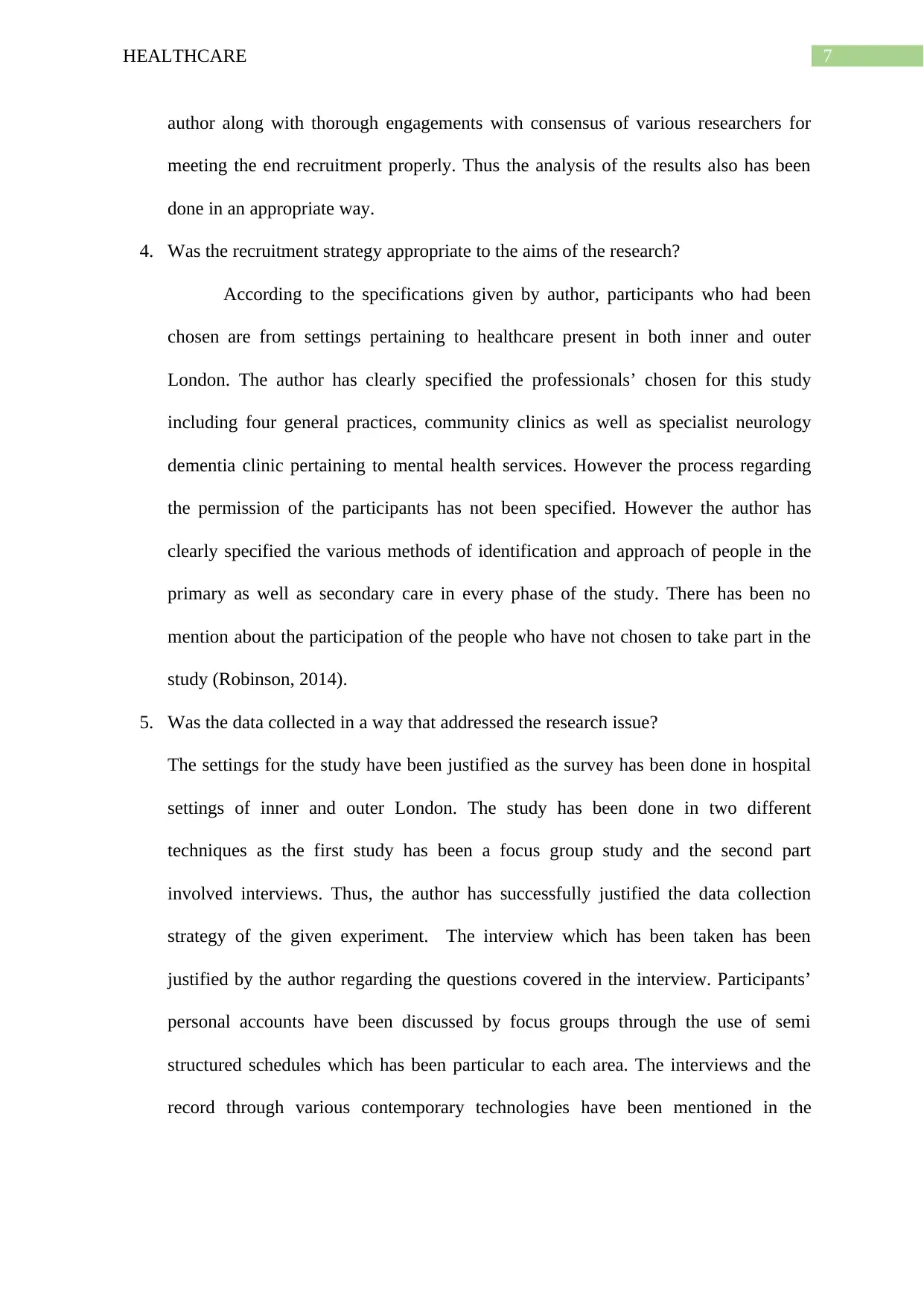
7HEALTHCARE
author along with thorough engagements with consensus of various researchers for
meeting the end recruitment properly. Thus the analysis of the results also has been
done in an appropriate way.
4. Was the recruitment strategy appropriate to the aims of the research?
According to the specifications given by author, participants who had been
chosen are from settings pertaining to healthcare present in both inner and outer
London. The author has clearly specified the professionals’ chosen for this study
including four general practices, community clinics as well as specialist neurology
dementia clinic pertaining to mental health services. However the process regarding
the permission of the participants has not been specified. However the author has
clearly specified the various methods of identification and approach of people in the
primary as well as secondary care in every phase of the study. There has been no
mention about the participation of the people who have not chosen to take part in the
study (Robinson, 2014).
5. Was the data collected in a way that addressed the research issue?
The settings for the study have been justified as the survey has been done in hospital
settings of inner and outer London. The study has been done in two different
techniques as the first study has been a focus group study and the second part
involved interviews. Thus, the author has successfully justified the data collection
strategy of the given experiment. The interview which has been taken has been
justified by the author regarding the questions covered in the interview. Participants’
personal accounts have been discussed by focus groups through the use of semi
structured schedules which has been particular to each area. The interviews and the
record through various contemporary technologies have been mentioned in the
author along with thorough engagements with consensus of various researchers for
meeting the end recruitment properly. Thus the analysis of the results also has been
done in an appropriate way.
4. Was the recruitment strategy appropriate to the aims of the research?
According to the specifications given by author, participants who had been
chosen are from settings pertaining to healthcare present in both inner and outer
London. The author has clearly specified the professionals’ chosen for this study
including four general practices, community clinics as well as specialist neurology
dementia clinic pertaining to mental health services. However the process regarding
the permission of the participants has not been specified. However the author has
clearly specified the various methods of identification and approach of people in the
primary as well as secondary care in every phase of the study. There has been no
mention about the participation of the people who have not chosen to take part in the
study (Robinson, 2014).
5. Was the data collected in a way that addressed the research issue?
The settings for the study have been justified as the survey has been done in hospital
settings of inner and outer London. The study has been done in two different
techniques as the first study has been a focus group study and the second part
involved interviews. Thus, the author has successfully justified the data collection
strategy of the given experiment. The interview which has been taken has been
justified by the author regarding the questions covered in the interview. Participants’
personal accounts have been discussed by focus groups through the use of semi
structured schedules which has been particular to each area. The interviews and the
record through various contemporary technologies have been mentioned in the
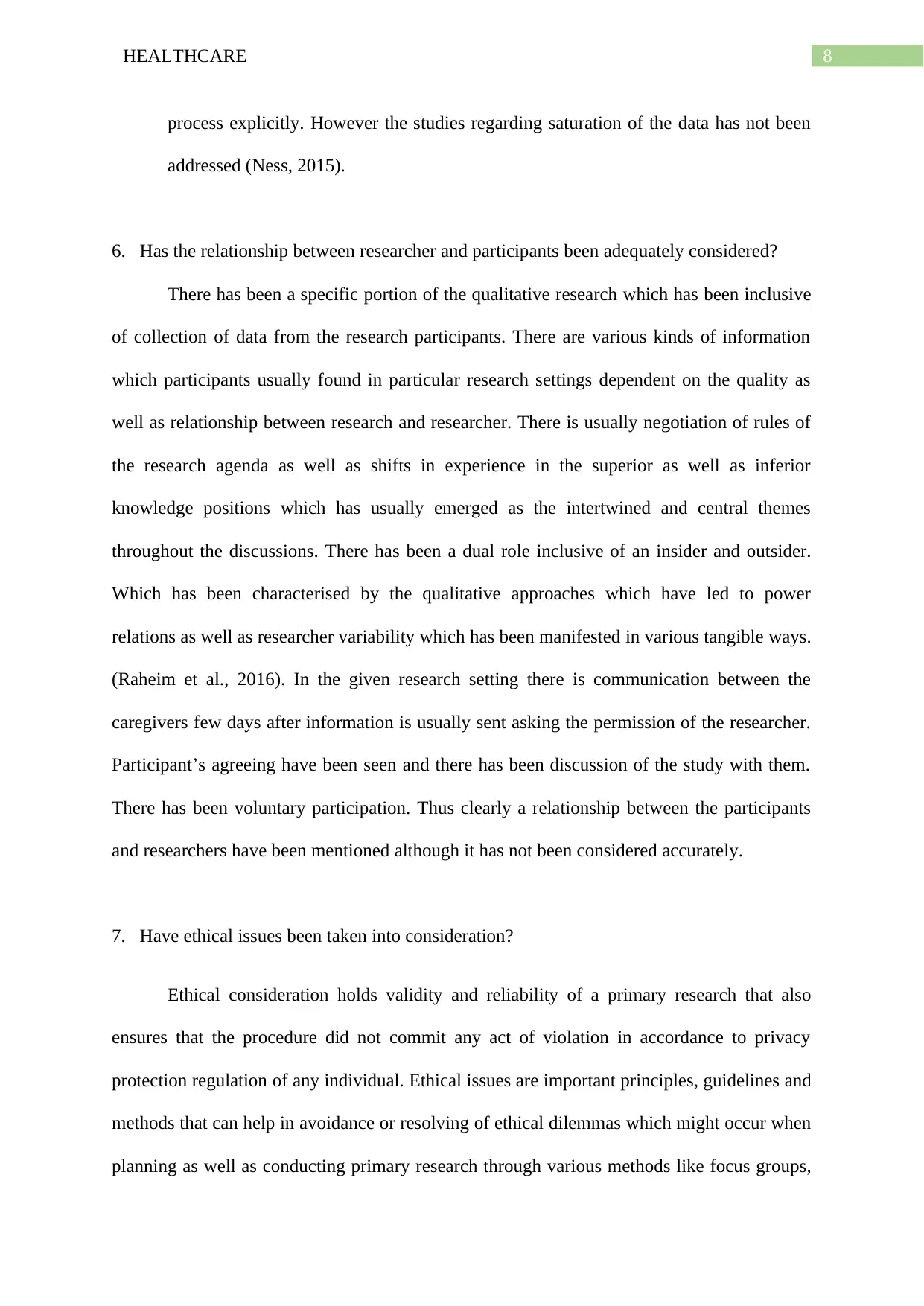
8HEALTHCARE
process explicitly. However the studies regarding saturation of the data has not been
addressed (Ness, 2015).
6. Has the relationship between researcher and participants been adequately considered?
There has been a specific portion of the qualitative research which has been inclusive
of collection of data from the research participants. There are various kinds of information
which participants usually found in particular research settings dependent on the quality as
well as relationship between research and researcher. There is usually negotiation of rules of
the research agenda as well as shifts in experience in the superior as well as inferior
knowledge positions which has usually emerged as the intertwined and central themes
throughout the discussions. There has been a dual role inclusive of an insider and outsider.
Which has been characterised by the qualitative approaches which have led to power
relations as well as researcher variability which has been manifested in various tangible ways.
(Raheim et al., 2016). In the given research setting there is communication between the
caregivers few days after information is usually sent asking the permission of the researcher.
Participant’s agreeing have been seen and there has been discussion of the study with them.
There has been voluntary participation. Thus clearly a relationship between the participants
and researchers have been mentioned although it has not been considered accurately.
7. Have ethical issues been taken into consideration?
Ethical consideration holds validity and reliability of a primary research that also
ensures that the procedure did not commit any act of violation in accordance to privacy
protection regulation of any individual. Ethical issues are important principles, guidelines and
methods that can help in avoidance or resolving of ethical dilemmas which might occur when
planning as well as conducting primary research through various methods like focus groups,
process explicitly. However the studies regarding saturation of the data has not been
addressed (Ness, 2015).
6. Has the relationship between researcher and participants been adequately considered?
There has been a specific portion of the qualitative research which has been inclusive
of collection of data from the research participants. There are various kinds of information
which participants usually found in particular research settings dependent on the quality as
well as relationship between research and researcher. There is usually negotiation of rules of
the research agenda as well as shifts in experience in the superior as well as inferior
knowledge positions which has usually emerged as the intertwined and central themes
throughout the discussions. There has been a dual role inclusive of an insider and outsider.
Which has been characterised by the qualitative approaches which have led to power
relations as well as researcher variability which has been manifested in various tangible ways.
(Raheim et al., 2016). In the given research setting there is communication between the
caregivers few days after information is usually sent asking the permission of the researcher.
Participant’s agreeing have been seen and there has been discussion of the study with them.
There has been voluntary participation. Thus clearly a relationship between the participants
and researchers have been mentioned although it has not been considered accurately.
7. Have ethical issues been taken into consideration?
Ethical consideration holds validity and reliability of a primary research that also
ensures that the procedure did not commit any act of violation in accordance to privacy
protection regulation of any individual. Ethical issues are important principles, guidelines and
methods that can help in avoidance or resolving of ethical dilemmas which might occur when
planning as well as conducting primary research through various methods like focus groups,
⊘ This is a preview!⊘
Do you want full access?
Subscribe today to unlock all pages.

Trusted by 1+ million students worldwide
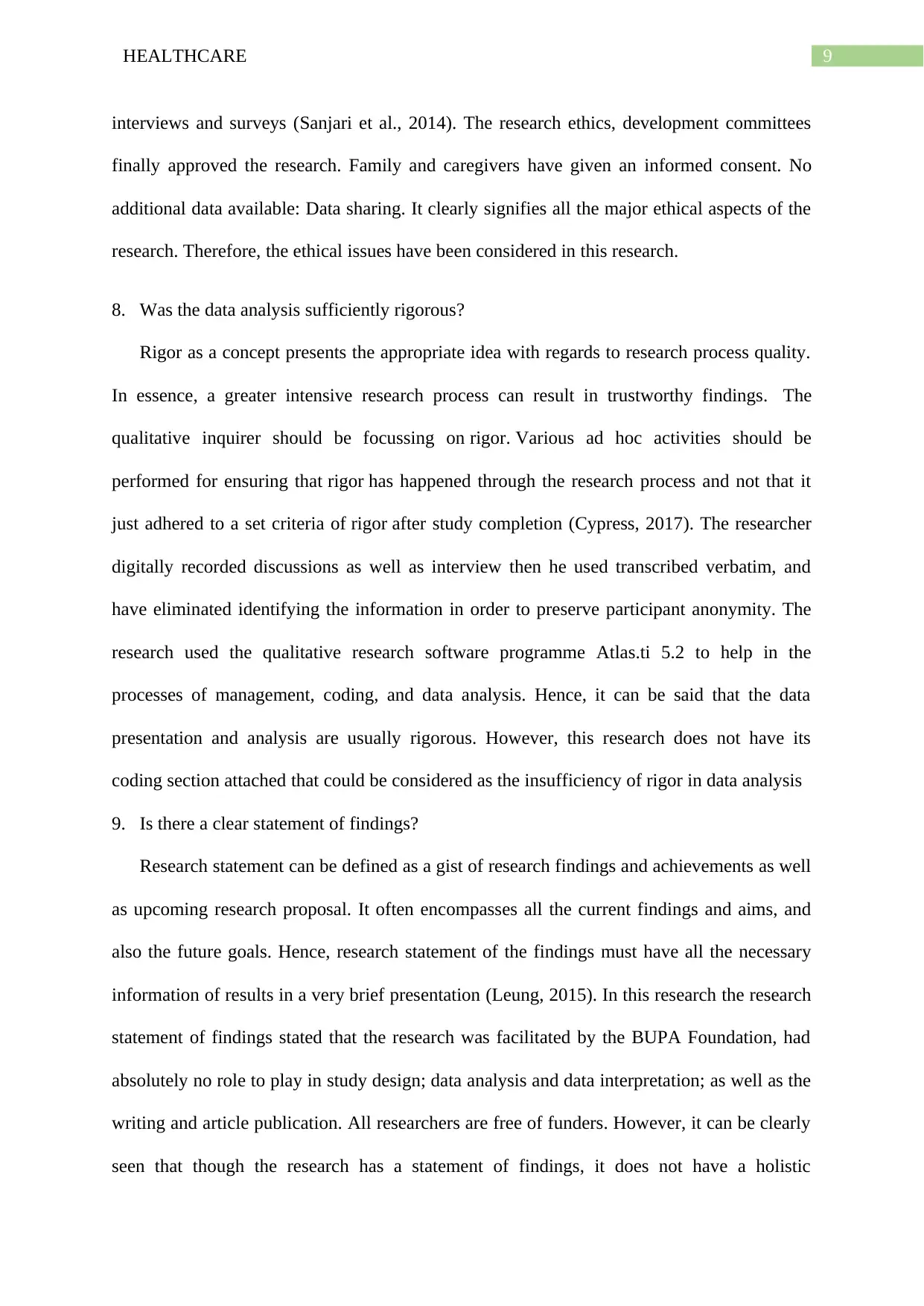
9HEALTHCARE
interviews and surveys (Sanjari et al., 2014). The research ethics, development committees
finally approved the research. Family and caregivers have given an informed consent. No
additional data available: Data sharing. It clearly signifies all the major ethical aspects of the
research. Therefore, the ethical issues have been considered in this research.
8. Was the data analysis sufficiently rigorous?
Rigor as a concept presents the appropriate idea with regards to research process quality.
In essence, a greater intensive research process can result in trustworthy findings. The
qualitative inquirer should be focussing on rigor. Various ad hoc activities should be
performed for ensuring that rigor has happened through the research process and not that it
just adhered to a set criteria of rigor after study completion (Cypress, 2017). The researcher
digitally recorded discussions as well as interview then he used transcribed verbatim, and
have eliminated identifying the information in order to preserve participant anonymity. The
research used the qualitative research software programme Atlas.ti 5.2 to help in the
processes of management, coding, and data analysis. Hence, it can be said that the data
presentation and analysis are usually rigorous. However, this research does not have its
coding section attached that could be considered as the insufficiency of rigor in data analysis
9. Is there a clear statement of findings?
Research statement can be defined as a gist of research findings and achievements as well
as upcoming research proposal. It often encompasses all the current findings and aims, and
also the future goals. Hence, research statement of the findings must have all the necessary
information of results in a very brief presentation (Leung, 2015). In this research the research
statement of findings stated that the research was facilitated by the BUPA Foundation, had
absolutely no role to play in study design; data analysis and data interpretation; as well as the
writing and article publication. All researchers are free of funders. However, it can be clearly
seen that though the research has a statement of findings, it does not have a holistic
interviews and surveys (Sanjari et al., 2014). The research ethics, development committees
finally approved the research. Family and caregivers have given an informed consent. No
additional data available: Data sharing. It clearly signifies all the major ethical aspects of the
research. Therefore, the ethical issues have been considered in this research.
8. Was the data analysis sufficiently rigorous?
Rigor as a concept presents the appropriate idea with regards to research process quality.
In essence, a greater intensive research process can result in trustworthy findings. The
qualitative inquirer should be focussing on rigor. Various ad hoc activities should be
performed for ensuring that rigor has happened through the research process and not that it
just adhered to a set criteria of rigor after study completion (Cypress, 2017). The researcher
digitally recorded discussions as well as interview then he used transcribed verbatim, and
have eliminated identifying the information in order to preserve participant anonymity. The
research used the qualitative research software programme Atlas.ti 5.2 to help in the
processes of management, coding, and data analysis. Hence, it can be said that the data
presentation and analysis are usually rigorous. However, this research does not have its
coding section attached that could be considered as the insufficiency of rigor in data analysis
9. Is there a clear statement of findings?
Research statement can be defined as a gist of research findings and achievements as well
as upcoming research proposal. It often encompasses all the current findings and aims, and
also the future goals. Hence, research statement of the findings must have all the necessary
information of results in a very brief presentation (Leung, 2015). In this research the research
statement of findings stated that the research was facilitated by the BUPA Foundation, had
absolutely no role to play in study design; data analysis and data interpretation; as well as the
writing and article publication. All researchers are free of funders. However, it can be clearly
seen that though the research has a statement of findings, it does not have a holistic
Paraphrase This Document
Need a fresh take? Get an instant paraphrase of this document with our AI Paraphraser
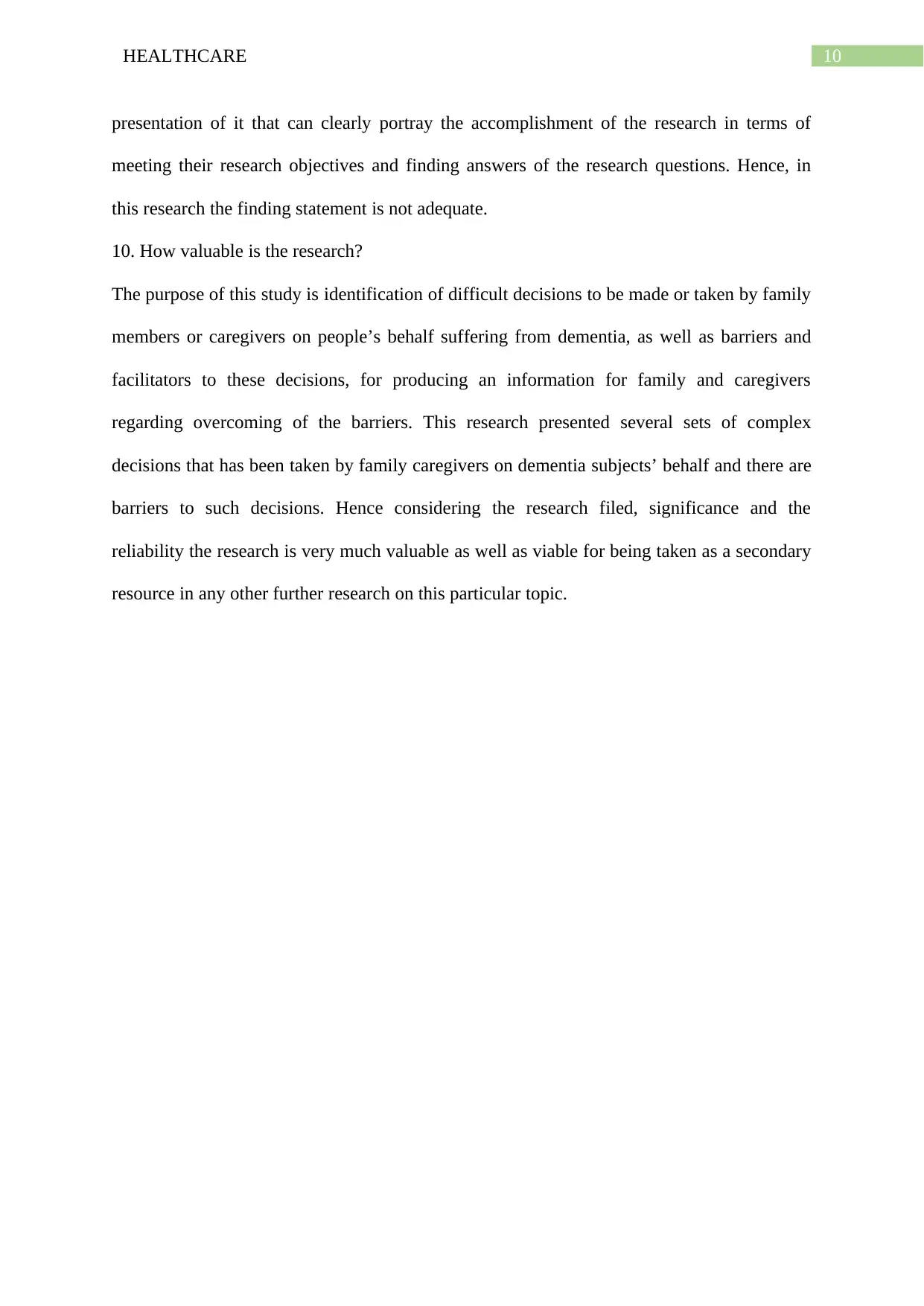
10HEALTHCARE
presentation of it that can clearly portray the accomplishment of the research in terms of
meeting their research objectives and finding answers of the research questions. Hence, in
this research the finding statement is not adequate.
10. How valuable is the research?
The purpose of this study is identification of difficult decisions to be made or taken by family
members or caregivers on people’s behalf suffering from dementia, as well as barriers and
facilitators to these decisions, for producing an information for family and caregivers
regarding overcoming of the barriers. This research presented several sets of complex
decisions that has been taken by family caregivers on dementia subjects’ behalf and there are
barriers to such decisions. Hence considering the research filed, significance and the
reliability the research is very much valuable as well as viable for being taken as a secondary
resource in any other further research on this particular topic.
presentation of it that can clearly portray the accomplishment of the research in terms of
meeting their research objectives and finding answers of the research questions. Hence, in
this research the finding statement is not adequate.
10. How valuable is the research?
The purpose of this study is identification of difficult decisions to be made or taken by family
members or caregivers on people’s behalf suffering from dementia, as well as barriers and
facilitators to these decisions, for producing an information for family and caregivers
regarding overcoming of the barriers. This research presented several sets of complex
decisions that has been taken by family caregivers on dementia subjects’ behalf and there are
barriers to such decisions. Hence considering the research filed, significance and the
reliability the research is very much valuable as well as viable for being taken as a secondary
resource in any other further research on this particular topic.
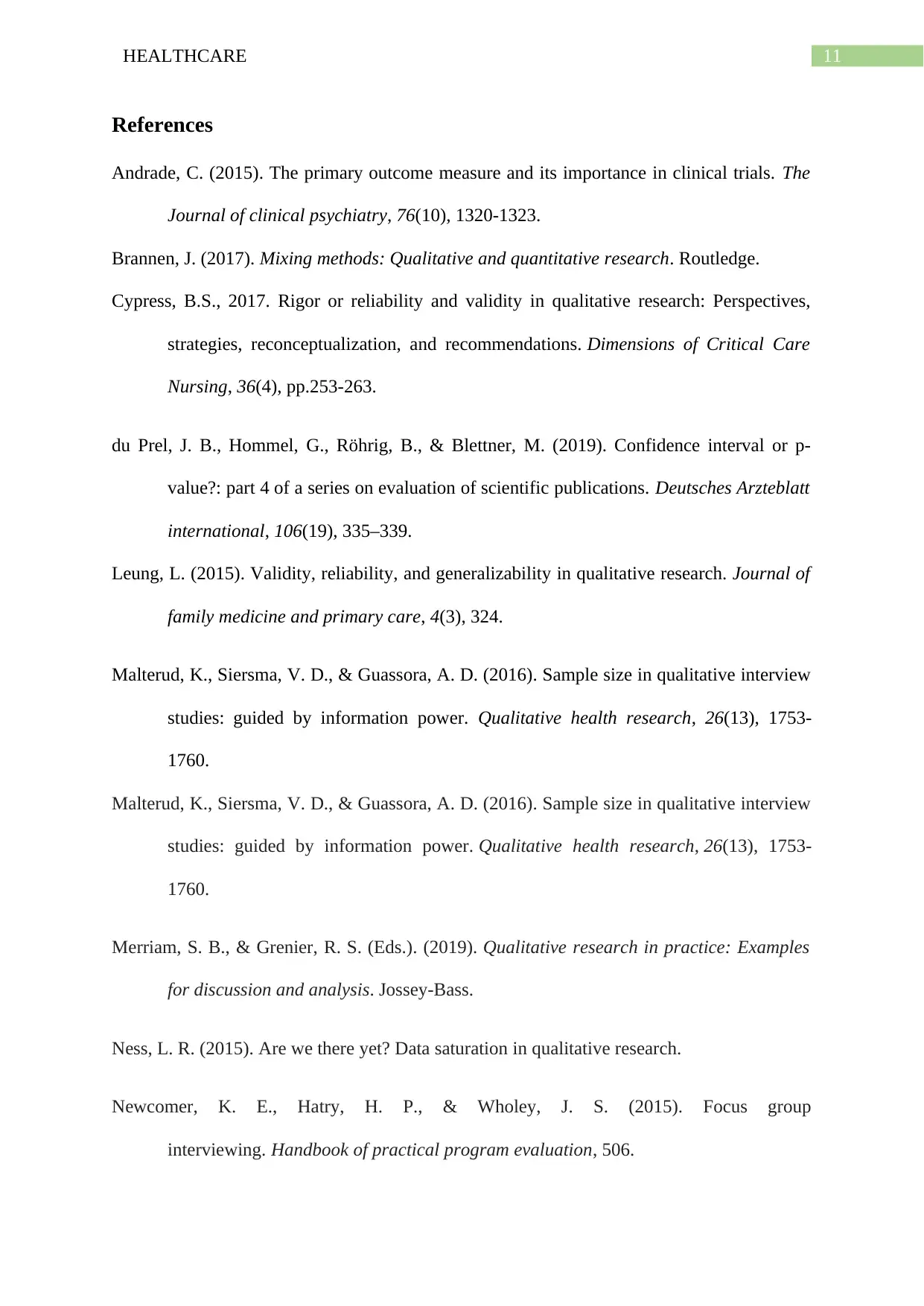
11HEALTHCARE
References
Andrade, C. (2015). The primary outcome measure and its importance in clinical trials. The
Journal of clinical psychiatry, 76(10), 1320-1323.
Brannen, J. (2017). Mixing methods: Qualitative and quantitative research. Routledge.
Cypress, B.S., 2017. Rigor or reliability and validity in qualitative research: Perspectives,
strategies, reconceptualization, and recommendations. Dimensions of Critical Care
Nursing, 36(4), pp.253-263.
du Prel, J. B., Hommel, G., Röhrig, B., & Blettner, M. (2019). Confidence interval or p-
value?: part 4 of a series on evaluation of scientific publications. Deutsches Arzteblatt
international, 106(19), 335–339.
Leung, L. (2015). Validity, reliability, and generalizability in qualitative research. Journal of
family medicine and primary care, 4(3), 324.
Malterud, K., Siersma, V. D., & Guassora, A. D. (2016). Sample size in qualitative interview
studies: guided by information power. Qualitative health research, 26(13), 1753-
1760.
Malterud, K., Siersma, V. D., & Guassora, A. D. (2016). Sample size in qualitative interview
studies: guided by information power. Qualitative health research, 26(13), 1753-
1760.
Merriam, S. B., & Grenier, R. S. (Eds.). (2019). Qualitative research in practice: Examples
for discussion and analysis. Jossey-Bass.
Ness, L. R. (2015). Are we there yet? Data saturation in qualitative research.
Newcomer, K. E., Hatry, H. P., & Wholey, J. S. (2015). Focus group
interviewing. Handbook of practical program evaluation, 506.
References
Andrade, C. (2015). The primary outcome measure and its importance in clinical trials. The
Journal of clinical psychiatry, 76(10), 1320-1323.
Brannen, J. (2017). Mixing methods: Qualitative and quantitative research. Routledge.
Cypress, B.S., 2017. Rigor or reliability and validity in qualitative research: Perspectives,
strategies, reconceptualization, and recommendations. Dimensions of Critical Care
Nursing, 36(4), pp.253-263.
du Prel, J. B., Hommel, G., Röhrig, B., & Blettner, M. (2019). Confidence interval or p-
value?: part 4 of a series on evaluation of scientific publications. Deutsches Arzteblatt
international, 106(19), 335–339.
Leung, L. (2015). Validity, reliability, and generalizability in qualitative research. Journal of
family medicine and primary care, 4(3), 324.
Malterud, K., Siersma, V. D., & Guassora, A. D. (2016). Sample size in qualitative interview
studies: guided by information power. Qualitative health research, 26(13), 1753-
1760.
Malterud, K., Siersma, V. D., & Guassora, A. D. (2016). Sample size in qualitative interview
studies: guided by information power. Qualitative health research, 26(13), 1753-
1760.
Merriam, S. B., & Grenier, R. S. (Eds.). (2019). Qualitative research in practice: Examples
for discussion and analysis. Jossey-Bass.
Ness, L. R. (2015). Are we there yet? Data saturation in qualitative research.
Newcomer, K. E., Hatry, H. P., & Wholey, J. S. (2015). Focus group
interviewing. Handbook of practical program evaluation, 506.
⊘ This is a preview!⊘
Do you want full access?
Subscribe today to unlock all pages.

Trusted by 1+ million students worldwide
1 out of 13
Related Documents
Your All-in-One AI-Powered Toolkit for Academic Success.
+13062052269
info@desklib.com
Available 24*7 on WhatsApp / Email
![[object Object]](/_next/static/media/star-bottom.7253800d.svg)
Unlock your academic potential
Copyright © 2020–2025 A2Z Services. All Rights Reserved. Developed and managed by ZUCOL.





